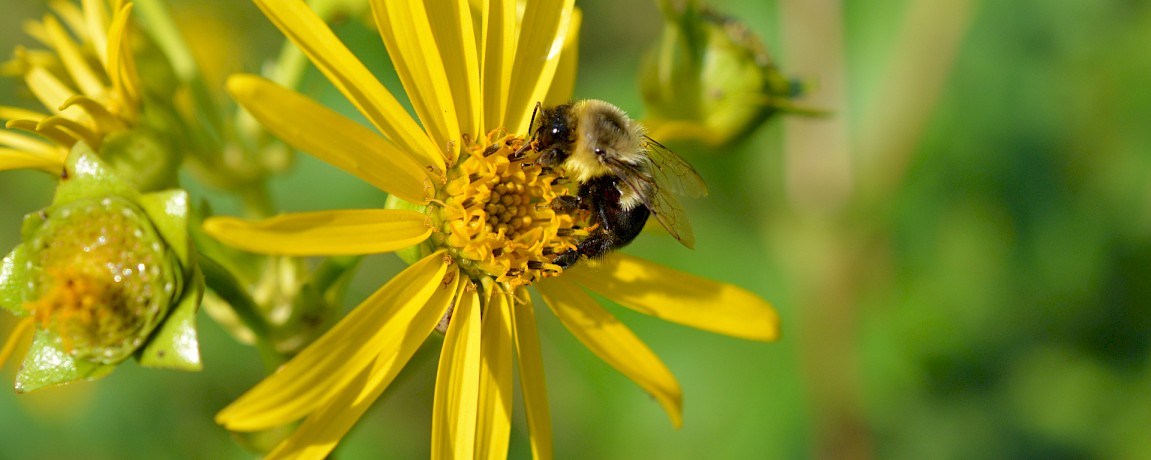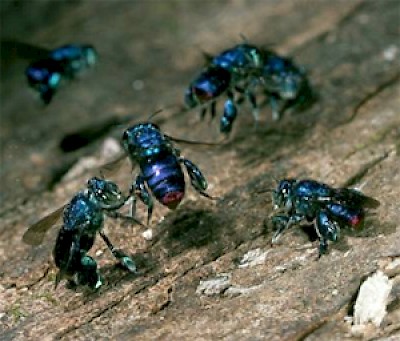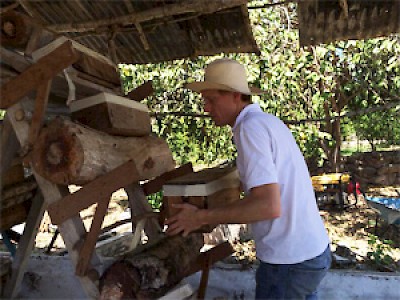Melipona Bees and the Honey of Yucatan
The Plight of the Honey Bee
Today we are all becoming increasingly aware of the plight of the honey bees. On every internet street corner, you can read about hive die-offs linked to pesticide use, genetically-modified foods, and mono-culture planting on mass scales that are diminishing bio-diversity and putting intense pressure on those tiny pollinators. The honey that many of us in the Western World usually eat comes from the European Honey Bee, apis mellifera. There is another honey bee, however, whose plight is more acute, whose honey is sublime, and who is teetering on the edge of extinction. Melipona beechi, or the stingless honey bee, is one of many species of bees that are indigenous to the Americas.
The Honey Bee of the Maya
Melipona beechii has been the honey bee of the Maya for millennia. Smaller in size than the European honey bee, the melipona beechi also cannot sting, making it a delightful species to keep at home. Traditionally, Mayan families would often have their hives tied to the sides of their homes, and indeed, in a handful of communities scattered across the Yucatan and in other parts of Mexico, primarily Puebla, you can find this practice still alive.
The Mayan bees are famous for their docile nature, but they differ in other ways as well. Their colonies are much smaller, so while the productivity of an individual bee is similar to that of the European honey bee, a hive of melipona beechi will produce only 2-3 litres of honey per year. Their stinging cousins produce a whopping 50 litres per year, a factor that has contributed to their widespread cultivation. In a world obsessed with volume, that puts the peaceful melipona beechi at a severe disadvantage. Until you taste the honey. Then you realize that Melipona honey is the closest thing on earth to the nectar of the gods.
Melipona honey is also highly bio-active, and has been used in traditional medicine for thousands of years. It is a fantastic topical antibiotic, its' use helps reduce scarring, it is used for treating cataracts, and it makes a wonderful antiseptic if you are coming down with a cold.
The Melipona bees co-evolved with the flora of semi-tropical and tropical Mexico. They are the bees that originally pollinated the tomato plant, and along with the bumblebee, are the only natural pollinators of tomatoes. Today, most commercially-grown tomatoes are pollinated by hand using vibrating wands. The Melipona bees pollinate orchids and are the main natural pollinator of the vanilla orchid. They also pollinate all the glorious wild trees that cover the Yucatan, and all plants that conventional bees just do not visit. So in addition to saving these bees for themselves, saving these bees is also of critical importance to the natural flora of the Yucatan Peninsula.
Beekeepers in Yucatan
In 2004, it was estimated by researchers at UADY, in conjunction with the Smithsonian Tropical Research Institute, that there were only 200 Melipona beekeepers left in the entire Yucatan Peninsula. Today, this number has dropped to just 120. Because these bees have co-evolved with mankind for so long, managed hives are often more successful and healthier than their wild cousins. Young people in the Maya communities these days do not have the time or the patience to take care of them, and the practice of their care is dying out.
Becoming a Beekeeper
We have started raising and caring for these bees in 2012, with the goal of training the people in our area, growing the bee population, and harvesting the honey. It is a challenging practice. The Melipona bees are vulnerable to many of the same things that plague the European bees. Because they have no stingers, these bees are also vulnerable to attacks from ants, flies, and even European bees, which try to take over their hives.
We believe that the best way to save this species is to create a market for its honey, and to take it to the world. The honey of Mexico, and of the Yucatan Peninsula in particular, is among the best honey in the world. This rare nectar is without doubt the most unique and flavorful honey that exists today. We encourage you to take the time to seek this honey out and try it for yourself. You will often find it sold in little vials at some of the many markets that pop up around Merida and in Valladolid. It is expensive, as much as $1,000 pesos for a liter (versus $10-50 pesos for a liter of conventional honey). This honey is worth it. We think it is also worth it to know that when you are buying it, you are preserving a culture, a way of life, an endangered species, and a threatened plant ecosystem. When you taste it, you will see that it is worth every penny.
Please follow us on Facebook.com/melipona. Stay informed, as there will be events and training, and both are ways to learn more about these bees and to participate in their care.
****
Travel Foundations' Melipona Bee Conservation Project
Story in WIRED magazine about beekeeping Maya women in Yucatan










Comments
Gordon 10 years ago
Great article. Thanks so much for posting.
My wife and I just spent a 10 days in the Yucatan area and visited a great little Cacao museum in Valladolid, where we learned about this great little honey bee. The museum was very interesting, not only promoting local cacao, but also the honey from these bees and other local products.
http://www.tripadvisor.com/Attraction_Review-g499453-d2357562-Reviews-Cacao-Valladolid_Yucatan_Peninsula.html
Reply
David Bliss 11 years ago
The amount of watered down European honey showing up needs to be stopped. I have had hives in the US for 30 years (and I'm only 43!). Anyway, I have a couple pieces of land in Akumal, Q Roo and we've set up 10 European hives. I have 8 more empty hives showing up soon and want to get into Melipone bees. It's not about money - it's about preserving and respecting the indigenous species. We have a vodka business there and have an opportunity to educate visitors on native species and produce true, certified Melipone honey for the area. If anyone out there wants to help with the project, I could use it. We don't need money, we need arms and legs and a passion for contributing to the cause.
Reply
patty 8 years ago
Hi David, Have you created your project of the melipone bees? and if so, would like to know more about this wonderful project.. thanks
Reply
Luis Becerra 8 years ago
Hi. Mail please.
Reply
Andrew Cramer 9 years ago
Hi there David! Just read your response that was posted some time ago. I'm planning to be in Tulum over the winter and wondered if you knew anyone or where I could buy stinging bees to continue bee sting therapy that I'm currently undertaking in New York?
Thanks in advance,
Andrew
Reply
Eben Lenderking 11 years ago
Hi Linda: That's great. See if you can find this honey over there. There are a number of people who raise these bees. You must take care when buying it as the temptations for some to adulterate are huge…All around Tulum there are a number of people who sell this honey, and also around Valladolid, though you can never find much more than a tiny amount.
Reply
Working Gringos 11 years ago
Thanks, Linda. Buen viaje!
Reply
Linda Averill 11 years ago
We leave for Merida and then Akumal, Yucatan tomorrow. I am intrigued with the legends/spiritual connections around bee-keeping in the Yucatan. We will probably also buy some honey from vendors along the Coba highway. I found an article in the Traveler magazine( National Geographic)-Jan/Feb 2012, that I think you would very much enjoy reading relative to bee-keeping and some of the bee-hives in Sian Kaan Biosphere and also around Coba. Very interesting and informative. Que te vaya bien! Linda
Reply
Working Gringos 11 years ago
Thank you, Phyllis!
Reply
Phyllis Boyd 11 years ago
Thank you for your article. After recently reading about the distilling of Yucatan's signature Xtabentun liqueur with fermented honey produced by honey bees from the nectar of the fragrant xtabentún flower, and searching unsuccessfully in Merida for a bottle of the honey, I succeeded in finding some in a hotel shop in Puerto Aventuras. It is an artesanal product called Miel de Xtabentun y Dzidzilche, but bottled in Coba. As anyone who has driven the highway between Tulum and Coba knows, there are various honey vendors in that area, and who knows what the full story is as to the origin of what I purchased.
It would be most helpful to have a lead on other Merida sources for Yucatan honey, other than the stalls of the Feria Xmatkuil each year.
Finally, I wish to share with other readers the link to a charming full-color chart of Yucatan honey flowers and honey-producing communities I found while searching for honey sources online: http://www.biodiversidad.gob.mx/usos/mieles/pdf/31_404.pdf
Best wishes to all contributors and fellow readers, Phyllis Boyd
Reply
« Back (10 to 17 comments)